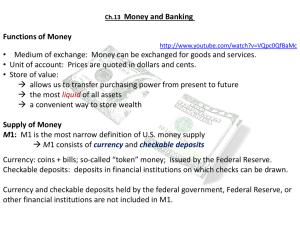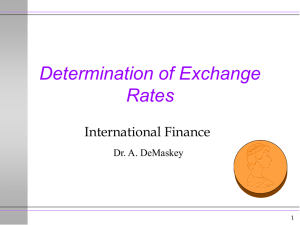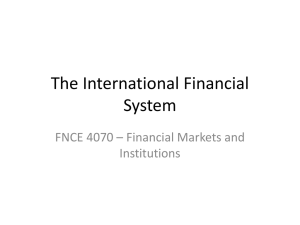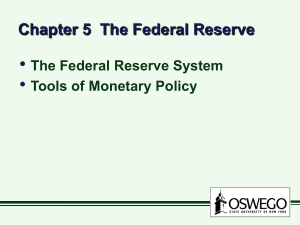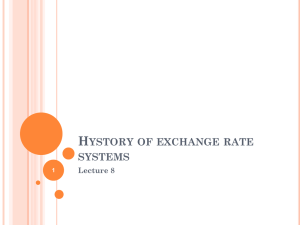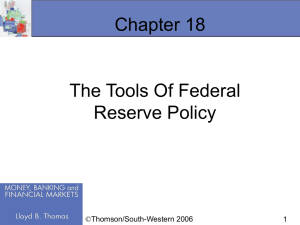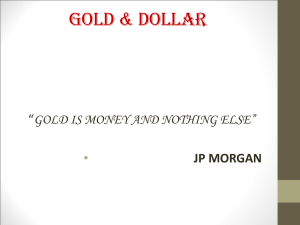QE put high risk for the world economy
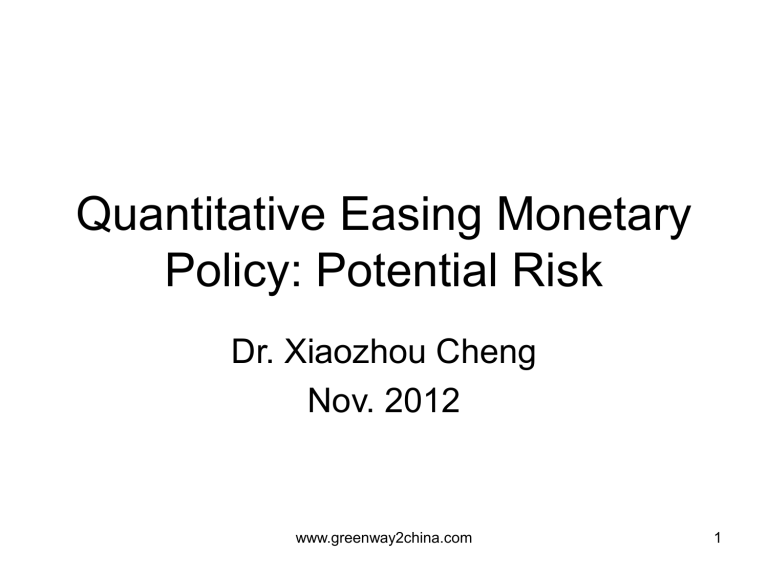
Quantitative Easing Monetary
Policy: Potential Risk
Dr. Xiaozhou Cheng
Nov. 2012 www.greenway2china.com
1
全球中央银行量化宽松货币政
策 : 制造潜在的金融危机
成小洲 博士
2012 年 11 月 www.greenway2china.com
2
What is the quantitative easing
(QE)
• Is QE to print more currency? Answer: NO
• Why?
• Balance sheet of central bank
• Assets side: increase domestic securities by implementing QE
• Liabilities side: increase the value of the reserve account of banks rather than the value of currency
• Printing money (bank notes): increase the value of currency www.greenway2china.com
3
QE increase reserve account
• Example: US Fed www.greenway2china.com
4
QE increase assets of central bank
• Example: US Fed www.greenway2china.com
5
What is QE
• QE monetary policy: purchase treasury bond or private securities (mortgage back securities)
• QE monetary policy does not mean printing more banknotes (currency), and means to buy government bonds or private securities from investment institutes, such as pension funds, insurance company. The central bank create electronic money through purchasing these securities. These investment institutes would buy another securities using the money which has been received by selling the government bonds to the central bank.
www.greenway2china.com
6
Extent of QE
• US Fed: QE1, Nov. 2008, $US 600 billion; QE2, Nov.
2010, $US 600 billion; QE3; Sept, 13, 2012, $US 40 billion every month until U.S. employment rate increase
• Bank of England: purchased £200 billion gilts between
March and Sept. 2009; purchased more £75 billion gilts in Oct. 2011; in Feb. and July, 2012, the Bank bought more £50 billion gilts respectively. The total assets that the bank purchased are £375 (during 2011 to 2012, the
Bank of England increased the amounts purchased gilts)
• Bank of Japan and European Central Bank also purchased the government bonds and private securities by the QE program www.greenway2china.com
7
Intention of QE
• Intention: lowers down the long term bond or securities interest rates
• Intention: reduces the investment cost
• Intention: stimulates the demand
(investment and consumption)
• Intention outcome: stimulates the economy www.greenway2china.com
8
Why choose QE
• Why central banks choose QE policy?
• Answer: the conventional monetary policy tools have reached their limitations
• Overnight interest rates have been close zero.
• Central banks are impotent in using conventional monetary policy instruments
• QE is extraordinary monetary policy tool www.greenway2china.com
9
History of QE policy
• Japan: used in its 1990s recession
• Bernanke, then a professor of Princeton
University, raised the advice on QE policy to
Bank of Japan
• US Fed reserve implemented QE1, QE2 and
QE3 in recent recession
• European Central Bank implemented QE in recent recession
• Bank of England implemented QE in recent recession www.greenway2china.com
10
QE and Inflation
• One of intentions of QE policy: boosting up the inflation rate (stimulate the economy)
• Experiences of QE policy: with respect to either Japan in 1990s or US, European or
England, inflation rates are still low, economy still undergo the recession
• Will inflation happen in the future due to
QE?
www.greenway2china.com
11
Why does the QE not work well
• By the economics text book, the QE should stimulate the economy, why the economy still undergoes the recession?
• Where has the extra money that the central bank injects through the QE gone?
• Does the extra money stay within the US? Answer: NO!
• Where is it? Emerging markets
• Why has the extra money not stayed within US?
• Explanation: By Keynesian economics, markets lost confidences on the future. It is not due to the high investment cost.
www.greenway2china.com
12
Effect of the QE
• One of direct effects of QE is the assets of central banks are popped up
• The advanced economy: the assets of central banks are popped up by QE through purchasing the government bonds and private securities
• Emerging economy: the assets of central banks are popped up by central banks sterilization program
• The extra money which the advanced economy central banks injected by QE flowed into the emerging economy.
• The central banks in the emerging markets has to absorbed the inflow hot money in order to relive the pressure on appreciation of their currencies
• Sterilization: the only choice for the emerging markets central banks
• Consequences: the assets of central banks all over the world have increased dramatically for last four years www.greenway2china.com
13
Scales of the assets of the main central banks
• China (2011, the ratio : 59.4% (GDP 47288160 million yuan, assets:
28097760 million yuan). By estimating 2012 the ratio will be more than 60%
• US Fed (2012 Oct Fed assets: $2.8 trillion, the ratio: more than 20%)
• European (eurosystem assets: 2012 sep. € 5.49 trillion, 2011 Dec. assets,
€4.7 trillion the ratio: 2011 GDP €9.42 trillion. the ratio in 2011: 49.89%
• England (the ratio: 26%)
• Japan (total assets: ¥139 trillion by the end of march 2012)
• India (total asset: 10.81 trillion ruppe by the end of sept. 2012. the ratio
13.3%)
• Russia (total assets 18.56 trillion rubles by end of 2011, the ratio is 31.16%)
• Brazil (total assets: 1.58 trillion Real. the ratio: 35% by the end of 2011)
• The ratio of the assets of central bank to GDP is more than 30% already www.greenway2china.com
14
Example US Fed Reserve
www.greenway2china.com
15
Example US Fed Reserve
www.greenway2china.com
16
Bank of England
• Assets: (source: the Bank of England) www.greenway2china.com
17
Bank of England
• Liabilities (source: the Bank of England) www.greenway2china.com
18
Hazard of large scale assets of central banks
• International financial system stabilities
• Financial assets bubble in the future (there is a time lag)
• Changing the foreign exchange rates and the term of trade in arena of international economic system www.greenway2china.com
19
QE pro up the prices of food and resources
• High prices of the food and resources impeded recovering the markets confidences www.greenway2china.com
20
Food price index up
• Food price index has been up since 2007
(Source: Food and Agriculture organization of United Nation) www.greenway2china.com
21
Example: China CPI and Food
Price
China CPI and Food price
16
14
12
10
8
2
0
6
4
20
10
-0
1
20
10
-0
3
20
10
-0
5
20
10
-0
7
20
10
-0
9
20
10
-1
1
20
11
-0
1
20
11
-0
3
20
11
-0
5
20
11
-0
7
20
11
-0
9
20
11
-1
1
20
12
-0
1
20
12
-0
3
20
12
-0
5
20
12
-0
7
20
12
-0
9
CPI
Food www.greenway2china.com
22
Cooper price has been up
• Cooper price has been up since 2008
(Sources: www.kitco.com) www.greenway2china.com
23
Crude oil price is up
• Crude oil price
(Brent Crude Oil markets five years) www.greenway2china.com
24
Crude oil price is up
• Crude oil price has been up since 2008
(WTI crude oil markets, 5 years range) www.greenway2china.com
25
Gold price has been up
• Gold price has been up dramatically www.greenway2china.com
26
Gold price has been up
• Gold price has been up dramatically since 2008
(source: www.goldprice.org) www.greenway2china.com
27
Gold price has been up
• The extent of gold price move by US dollar
• 2009 up 23.4%; 2010, up 27.1%, 2011, up
10.1%, 2012 (to Oct.), up 6.9% www.greenway2china.com
28
Impact on foreign exchange rate
• Emerging markets currency facing pressure on appreciation against US dollar, Euro and British
Pound. For example, China renminbi,
• Resource-rich country currency facing pressure on appreciation against US dollar, Euro, and
British Pound. For example, Canadian dollar,
Australian Dollar
• Japan Yen, Switzerland franc and Hong Kong dollar are also facing appreciation pressure www.greenway2china.com
29
Impact on China economy
• Impeded China economy recovering from the latest world economic recession
• China has implemented export-oriented economic development strategy for last three decades; the high growth rate of economy in China has been dependent on this strategy and fast growing world demand.
• China economy has already slowed down since 2009 because of the slowing down demand of the western world.
• Appreciating Chinese currency, renminbi, reduces the competitive of Chinese goods in the world markets www.greenway2china.com
30
Impact on Canadian economy
• Canadian, although live a resource-rich country, has not get benefits from the high price of the resources.
• Canadian has to pay more money to gas and food, since the prices of oil and food in the international markets have been hiking up. Consumers are losing confidence due to high living cost
• The exchange rate of Canadian dollar against US dollar has been up for last ten years because of Canada is a resource-rich country
• High Canadian dollar worse the term of trade of Canada www.greenway2china.com
31
Impacts on Japan, Switzerland and
Hong Kong
• The terms of trade of these countries are worse off since the values of their currencies against US dollar is up
• The central banks or monetary authority in the country and region have to sterilize the inflowing capital and keep their own currency value stable.
• These economic entities are facing high pressure on inflation www.greenway2china.com
32
QE monetary policy hurdles the world economy from fast recovering
• High food prices and high gas prices degrades the consumer confidences on the future
• Appreciated currencies of emerging markets and declining demand of the western markets impeded recovering economy of emerging markets
• High values of Japanese Yen and Canadian dollar hurdled the economic recovering from this five-year recession www.greenway2china.com
33


